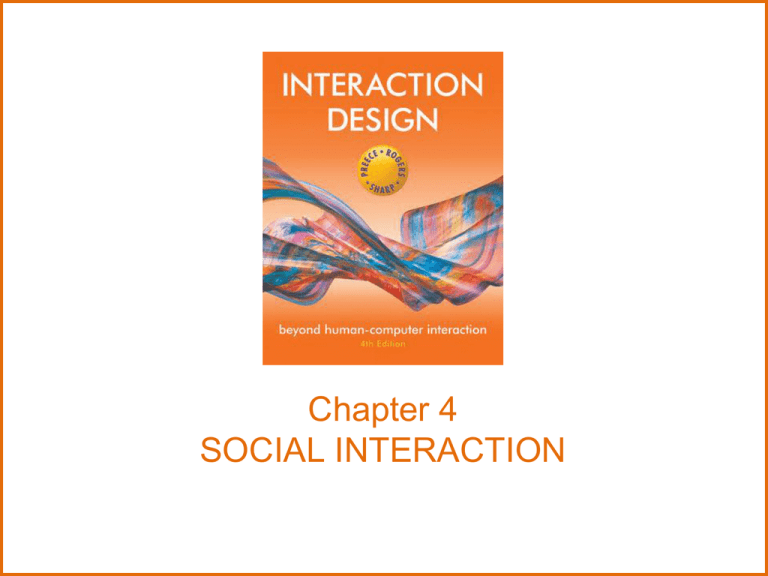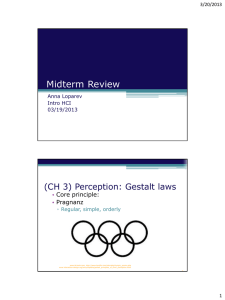Chapter 4 SOCIAL INTERACTION
advertisement

Chapter 4 SOCIAL INTERACTION Overview • Being social • Face to face conversations • Remote conversations • Tele-presence • Co-presence • Shareable technologies www.id-book.com 2 Conversational mechanisms • Various mechanisms and ‘rules’ are followed when holding a conversation, e.g. mutual greetings A: Hi there B: Hi! C: Hi A: All right? C: Good, how’s it going? A: Fine, how are you? C: OK B: So-so. How’s life treating you? www.id-book.com 3 Being social • Are F2F conversations being superseded by our social media interactions? • How many friends do you have on Facebook, LinkedIn,etc vs real life? • How much overlap? • How are the ways we live and interact with one another changing? • Are the established rules and etiquette still applicable to online and offline? www.id-book.com 4 Conversational rules • Sacks et al. (1978) work on conversation analysis describe three basic rules: Rule 1: the current speaker chooses the next speaker by asking an opinion, question, or request Rule 2: another person decides to start speaking Rule 3: the current speaker continues talking www.id-book.com 5 Conversational rules • Turn-taking used to coordinate conversation – A: Shall we meet at 8? – B: Um, can we meet a bit later? – A: Shall we meet at 8? – B: Wow, look at him? – A: Yes what a funny hairdo! – B: Um, can we meet a bit later? • Back channelling to signal to continue and following – Uh-uh, umm, ahh www.id-book.com 6 More conversational rules • Farewell rituals – Bye then, see you, yer bye, see you later…. • Implicit and explicit cues – e.g. looking at watch, fidgeting with coat and bags – explicitly saying “Oh dear, must go, look at the time, I’m late…” www.id-book.com 7 Breakdowns in conversation • When someone says something that is misunderstood: – Speaker will repeat with emphasis: A: “this one?” B: “no, I meant that one!” – Also use tokens: Eh? Quoi? Huh? What? www.id-book.com 8 What happens in social media conversations? • Do same conversational rules apply? • Are there more breakdowns? • How do people repair them for: – – – – – Phone? email? Instant messaging? texting? Skyping? www.id-book.com 9 Remote conversations • Much research on how to support conversations when people are ‘at a distance’ from each other • Many applications have been developed – e.g., email, videoconferencing, videophones, instant messaging, chatrooms • Do they mimic or move beyond existing ways of conversing? www.id-book.com 10 Early videophone and visualphone www.id-book.com 11 VideoWindow system (Bellcore, 1989) • Shared space that allowed people 50 miles apart to carry on a conversation as if in same room drinking coffee together • 3 x 8 ft ‘picture-window’ between two sites with video and audio • People did interact via the window but strange things happened (Kraut, 1990) www.id-book.com 12 Sketch of VideoWindow www.id-book.com 13 Findings of how VideoWindow System was used • Talked constantly about the system • Spoke more to other people in the same room rather than in other room • When tried to get closer to someone in other place had opposite effect - went out of range of camera and microphone • No way of monitoring this www.id-book.com 14 Skype success • Global household name • Seeing others on screen enables more intimacy than audio phone • Enables people to get to know each other better • Less awkward for young children – Like “to show, not tell” (Ames et al, 2010) www.id-book.com 15 3D virtual worlds • Second Life (2007) – Over 8 million users • What kinds of conversation take place in these environments? • VoIP versus chatroom talk? – Which is preferred and why? www.id-book.com 16 Facebook and Twitter • Everyone uses them so what is there to learn? • Used in emergencies, demos, etc., – e.g., users spread up-to-the minute info and retweet about how a wildfire or gas plume is moving – but can also start or fuel rumours, by adding news that is old or incorrect – more confusing than helpful www.id-book.com 17 Telepresence • New technologies designed to allow a person to feel as if they were present in the other location – projecting their body movements, actions, voice and facial expressions to the other location or person – e.g. superimpose images of the other person on a workspace www.id-book.com 18 Hypermirror (Morikawa and Maesako, 1998) – allows people to feel as if they are in the same virtual place even though in physically different spaces (woman in white sweater is in a different room to the other three) People in different places are superimposed on the same screen to make them appear as if in same space www.id-book.com 19 Creating personal space in Hypermirror 2) Two in this room are invading the ‘virtual’ personal space of the other person by appearing to be physically on top of woman in white sweater www.id-book.com 3) Two in the room move apart to allow person in other space more ‘virtual’ personal space 20 Everyone happy www.id-book.com 21 BiReality www.id-book.com 22 The People’s Bot attending CHI www.id-book.com 23 A telepresence room www.id-book.com 24 How much realism? • Is needed in telepresence to make it compelling? • Telepresence rooms try make the remote people appear to be life-like by using multiple high def cameras with eyetracking features and directional microphones • Is Skype just as good? www.id-book.com 25 Coordination mechanisms • When a group of people act or interact together they need to coordinate themselves – e.g., playing football, navigating a ship • They use: – verbal and non-verbal communication – schedules, rules, and conventions – shared external representations www.id-book.com 26 Co-presence • Technologies that enable co-located groups to collaborate more effectively – when working, learning and socializing • Examples: Smartboards, Surfaces, Wii and Kinect www.id-book.com 27 F2F coordinating mechanisms • Talk is central • Non-verbal also used to emphasize and as substitute – e.g. nods, shakes, winks, glances, gestures and hand-raising • Formal meetings – explicit structures such as agendas, memos, and minutes are employed to coordinate the activity www.id-book.com 28 Awareness mechanisms • Involves knowing who is around, what is happening, and who is talking with whom • Peripheral awareness – keeping an eye on things happening in the periphery of vision – Overhearing and overseeing - allows tracking of what others are doing without explicit cues www.id-book.com 29 Lo tech awareness mechanism www.id-book.com 30 Designing technologies to support awareness • Provide awareness of others who are in different locations • Workspace awareness: “the up-to-themoment understanding of another person’s interaction with the shared workspace” (Gutwin and Greenberg, 2002) • Examples: ReacTable and Reflect Table www.id-book.com 31 The Reactable experience www.id-book.com 32 The Reflect Table www.id-book.com 33 The Dynamo system www.id-book.com 34 Notification systems • Users notify others as opposed to being constantly monitored • Provide information about shared objects and progress of collaborative tasks – example: Babble www.id-book.com 35 Sococo – shows who is where and who is meeting with whom www.id-book.com 36 What next? • Besides perpetual sharing and broadcasting of information, knowledge, and personal content? • Lifelogging – recording everything in one’s life and sharing • Micro-chatting – beyond twitter and snapchat? www.id-book.com 37 Summary • Social mechanisms, like turn-taking, conventions, etc., enable us to collaborate and coordinate our activities • Keeping aware of what others are doing and letting others know what you are doing are important aspects of collaborative working and socialising • Many technologies systems have been built to support telepresence and co-presence www.id-book.com 38







